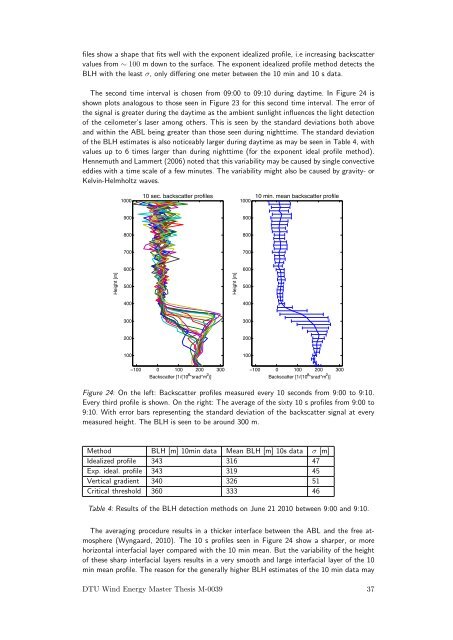Boundary-layer height detection with a ceilometer at a coastal ... - Orbit
Boundary-layer height detection with a ceilometer at a coastal ... - Orbit
Boundary-layer height detection with a ceilometer at a coastal ... - Orbit
You also want an ePaper? Increase the reach of your titles
YUMPU automatically turns print PDFs into web optimized ePapers that Google loves.
files show a shape th<strong>at</strong> fits well <strong>with</strong> the exponent idealized profile, i.e increasing backsc<strong>at</strong>ter<br />
values from ∼ 100 m down to the surface. The exponent idealized profile method detects the<br />
BLH <strong>with</strong> the least σ, only differing one meter between the 10 min and 10 s d<strong>at</strong>a.<br />
The second time interval is chosen from 09:00 to 09:10 during daytime. In Figure 24 is<br />
shown plots analogous to those seen in Figure 23 for this second time interval. The error of<br />
the signal is gre<strong>at</strong>er during the daytime as the ambient sunlight influences the light <strong>detection</strong><br />
of the <strong>ceilometer</strong>’s laser among others. This is seen by the standard devi<strong>at</strong>ions both above<br />
and <strong>with</strong>in the ABL being gre<strong>at</strong>er than those seen during nighttime. The standard devi<strong>at</strong>ion<br />
of the BLH estim<strong>at</strong>es is also noticeably larger during daytime as may be seen in Table 4, <strong>with</strong><br />
values up to 6 times larger than during nighttime (for the exponent ideal profile method).<br />
Hennemuth and Lammert (2006) noted th<strong>at</strong> this variability may be caused by single convective<br />
eddies <strong>with</strong> a time scale of a few minutes. The variability might also be caused by gravity- or<br />
Kelvin-Helmholtz waves.<br />
1000<br />
10 sec. backsc<strong>at</strong>ter profiles<br />
1000<br />
10 min. mean backsc<strong>at</strong>ter profile<br />
900<br />
900<br />
800<br />
800<br />
700<br />
700<br />
600<br />
600<br />
Height [m]<br />
500<br />
Height [m]<br />
500<br />
400<br />
400<br />
300<br />
300<br />
200<br />
200<br />
100<br />
100<br />
−100 0 100 200 300<br />
−100 0 100 200 300<br />
Backsc<strong>at</strong>ter [1/(10 8 *srad*m 2 )]<br />
Backsc<strong>at</strong>ter [1/(10 8 *srad*m 2 )]<br />
Figure 24: On the left: Backsc<strong>at</strong>ter profiles measured every 10 seconds from 9:00 to 9:10.<br />
Every third profile is shown. On the right: The average of the sixty 10 s profiles from 9:00 to<br />
9:10. With error bars representing the standard devi<strong>at</strong>ion of the backsc<strong>at</strong>ter signal <strong>at</strong> every<br />
measured <strong>height</strong>. The BLH is seen to be around 300 m.<br />
Method BLH [m] 10min d<strong>at</strong>a Mean BLH [m] 10s d<strong>at</strong>a σ [m]<br />
Idealized profile 343 316 47<br />
Exp. ideal. profile 343 319 45<br />
Vertical gradient 340 326 51<br />
Critical threshold 360 333 46<br />
Table 4: Results of the BLH <strong>detection</strong> methods on June 21 2010 between 9:00 and 9:10.<br />
The averaging procedure results in a thicker interface between the ABL and the free <strong>at</strong>mosphere<br />
(Wyngaard, 2010). The 10 s profiles seen in Figure 24 show a sharper, or more<br />
horizontal interfacial <strong>layer</strong> compared <strong>with</strong> the 10 min mean. But the variability of the <strong>height</strong><br />
of these sharp interfacial <strong>layer</strong>s results in a very smooth and large interfacial <strong>layer</strong> of the 10<br />
min mean profile. The reason for the generally higher BLH estim<strong>at</strong>es of the 10 min d<strong>at</strong>a may<br />
DTU Wind Energy Master Thesis M-0039 37
















